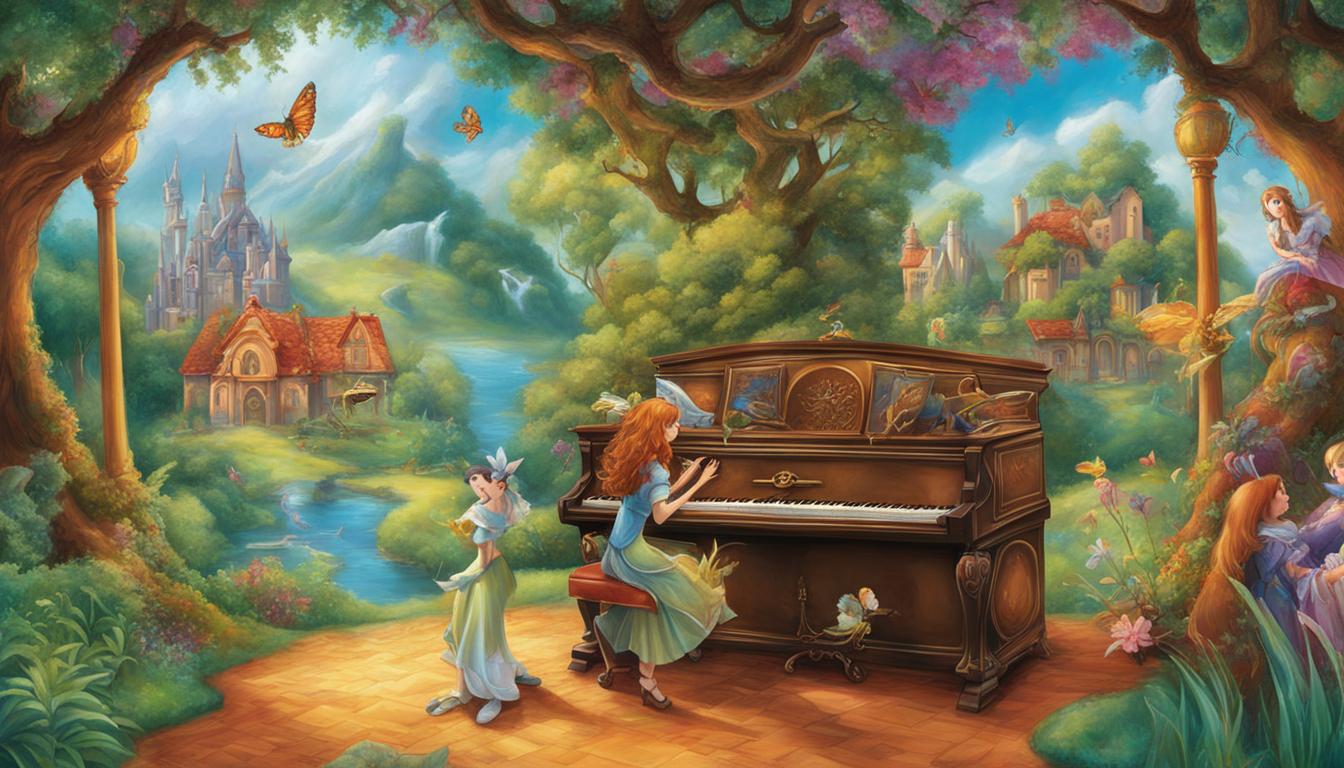Are you a fan of plays that transport you to a world of vibrant storytelling, tantalizing melodies, and unforgettable characters? Look no further than Nora Ephron’s “Imaginary Friends,” a captivating play with music that will leave you spellbound from beginning to end.
In this book summary, we’ll take an in-depth look at the compelling story and the musical compositions that make up this theatrical masterpiece. We’ll also explore the author’s background, the key themes of the play, and the critical reception it has received.
Get ready for an unforgettable journey through the imaginary world of Nora Ephron!
Key Takeaways:
- Nora Ephron’s “Imaginary Friends” is a must-read for anyone who loves plays with compelling stories and memorable characters.
- The play combines captivating storytelling with vibrant musical compositions.
- Themes explored in the play include friendship, imagination, identity, and the power of storytelling.
- The critical reception to “Imaginary Friends” has been positive, with many reviewers praising its strengths.
- This book summary provides readers with a comprehensive overview of the play’s key aspects, without giving away any major spoilers.
About Nora Ephron
Nora Ephron was an American playwright, writer, and filmmaker, born on May 19th, 1941, in New York City. Her parents were both screenwriters and had a significant influence on her life and work. After graduating from Wellesley College, Ephron began her professional career as a journalist, working for publications such as the New York Post and Esquire. She later transitioned to screenwriting and gained critical acclaim for her work on films such as “Silkwood,” “When Harry Met Sally…” and “Sleepless in Seattle.”
Ephron’s success in the film industry led her to explore other forms of storytelling, including theater. Her first play, “Imaginary Friends,” premiered in 2002 and was staged by the esteemed director Jack O’Brien. The play received favorable reviews and showcased Ephron’s talent for combining humor with poignant themes.
Ephron’s body of work spans across various genres, but her attention to character development and witty dialogue are evident in all her works. She was a pioneer for female voices in the entertainment industry and inspired many aspiring writers and filmmakers to follow in her footsteps.
“I try to write parts for women that are as complicated and interesting as women actually are.”
The Concept of “Imaginary Friends”
At the heart of Nora Ephron’s play with music, “Imaginary Friends,” lies the captivating concept of imaginary friends. These imaginary beings serve as a significant theme throughout the play, giving readers a glimpse into the power of imagination and creativity.
The concept of imaginary friends in the play explores the idea of escaping reality and creating an alternate world, one that is often more exciting and fulfilling than our own. It delves into the imagination of children, highlighting the importance of creativity and self-discovery in their growth and development.
Moreover, imaginary friends also signify our need for companionship and support, especially during difficult times. They serve as a shoulder to lean on when real-life friends are scarce or absent, and they offer comfort and solace when we feel alone.
The significance of imaginary friends in the play also ties in with the overarching theme of storytelling. Through the imaginary friends’ stories and adventures, the play invites readers on a journey of self-discovery, one that underlines the transformative power of storytelling.
In summary, the concept of imaginary friends provides a fascinating insight into the power of the imagination, the significance of companionship, and the transformative nature of storytelling.
Characters in “Imaginary Friends”
As the title suggests, “Imaginary Friends” revolves around two characters. One is the talented author, Mary McCarthy, while the other is her best friend and fellow writer, Lillian Hellman. Mary is a witty, intelligent writer who has just published her novel, while Lillian is a brilliant playwright with an explosive personality.
Other essential characters in the play include:
- James: Mary’s husband, who is unimpressed with her literary success and prefers to spend time at the bar.
- Barnes: A publisher who is willing to do just about anything to sign Mary to a new contract.
- Stephen: Lillian’s husband, who is financially supporting her career while receiving little credit for his contributions.
- Sheri: Lillian’s secretary- turned-friend, who is fiercely loyal to her.
Each character plays a critical role in the storyline, contributing to the play’s central theme of friendship, imagination, and the power of storytelling. Readers will enjoy getting to know each of these characters and the dynamic relationships between them.
The Theatrical Melodies of Life
Music is an essential element in Nora Ephron’s play, “Imaginary Friends.” Through the use of theatrical melodies, music enhances the storytelling and complements the emotions evoked within the audience. With enticing melodies and captivating rhythms, the music sets the tone for the play, taking the viewers on a profound and compelling journey.
These musical arrangements in “Imaginary Friends” present a unique and captivating reflection of different aspects of life. From the playful and whimsical melodies that capture the innocence of childhood to the more complex and soulful compositions that evoke sorrow and depth of emotion, the theatrical melodies in the play symbolize a journey through life. They mirror the highs and lows, the joys and sorrows, and the beauty and complexity of life experiences.

“Music is the universal language of mankind.” – Henry Wadsworth Longfellow
Ephron’s play has effectively used this universal language to connect with its audience and convey the essence of life’s experiences through the theatrical melodies. It celebrates the beauty of life, the wonder of imagination, and the magic of genuine connections that define human existence. The musical arrangements in “Imaginary Friends” are a masterpiece, capturing the essence of the play’s themes in a way that words alone cannot express.
Thus, the use of theatrical melodies in Nora Ephron’s play highlights the importance of music in our lives as a reflection of our experiences, emotions, and memories. It makes “Imaginary Friends” a sensory delight that is worth experiencing.
Plot Summary
Imaginary Friends is a play with music that follows the lives of two literary icons, Lillian Hellman and Mary McCarthy, as they navigate their personal and professional relationships. The story is set in the mid-20th century and spans several years, chronicling the ups and downs of the two writers as they juggle their ambitions, love lives, and feuds.
The play begins with the introduction of Lillian and Mary, two very different women with a shared passion for writing. Despite their different approaches to literature and personalities, they become friends, but their friendship is tested when Lillian suspects Mary has maliciously accused her of being a liar on national television. This sparks a feud that lasts for years, with both women writing negatively about each other in their respective works.
As the story progresses, the women’s personal lives become intertwined, as they deal with affairs, marriages, and divorces. Lillian’s relationship with a younger man named Peter also becomes a focus of the plot, causing tension between her and her closest friends. Meanwhile, Mary faces a health crisis that forces her to reassess her priorities and her relationship with Lillian.
Despite their differences and feuds, Lillian and Mary share a deep connection and an appreciation for each other’s writing. Their complex relationship is the heart of the play, and the story’s resolution hinges on whether they can reconcile their differences and rebuild their friendship.
Themes Explored
“Imaginary Friends” is rich with themes that explore the complexities of human experience. From the power of storytelling to the importance of friendship, Nora Ephron masterfully weaves together themes that resonate deeply with readers.
One of the most prominent themes in the play is the concept of imaginary friends, which serves as a metaphor for the human need for imagination and creativity. Through the characters’ relationships with their imaginary friends, Ephron highlights the importance of embracing our imaginations and tapping into our creativity as a means of coping with the challenges of life.
Friendship is another prevalent theme in the play. The complex relationships between the characters underscore the importance of strong and supportive friendships in navigating life’s ups and downs.
The theme of identity is also explored in “Imaginary Friends.” Through the characters’ struggles with self-doubt and self-discovery, readers are reminded of the importance of accepting oneself and finding one’s place in the world.
Finally, the power of storytelling is a theme that resonates throughout the play. Through the characters’ narratives and the use of musical elements, Ephron underscores the importance of storytelling as a means of healing and connection.
The Significance of Exploration
“Imaginary Friends” invites readers to explore the deeply profound human experiences and themes presented. By delving deeply into these themes, readers are able to gain valuable insights and uncover new understandings of the complexities of life. The play encourages readers to embrace their imaginations, celebrate friendship, and courageously explore the full range of human emotions.
“The true sign of intelligence is not knowledge but imagination.” – Albert Einstein
Critical Reception and Impact
Since its release, “Imaginary Friends” by Nora Ephron has garnered a mixed bag of reviews from critics and audiences alike. While some praised the play’s witty dialogue, infectious music, and powerful storytelling, others criticized it for being overly sentimental and contrived.
Despite the mixed reviews, “Imaginary Friends” has had a significant impact on the theater community. The play’s exploration of imaginary friends, the power of storytelling, and the complexity of friendships has resonated with many audiences, inspiring thought-provoking conversations and discussions.
Furthermore, Nora Ephron’s legacy as a pioneering playwright, writer, and filmmaker has further cemented “Imaginary Friends” as a standout success in her impressive career.
In conclusion, “Imaginary Friends” may not have been universally praised by critics, but its impact cannot be understated. The play’s themes and characters continue to resonate with audiences, speaking to the power of storytelling to connect us all.
Conclusion
In conclusion, Nora Ephron’s “Imaginary Friends” is a captivating play that explores the themes of friendship, imagination, and the power of storytelling. The play’s characters are well-developed, and the music enhances the narrative, providing a unique theatrical experience for audiences.
Overall, the play is a testament to Nora Ephron’s talent as a writer and playwright, showcasing her ability to craft stories that resonate with readers and theater-goers alike. For those who enjoy thought-provoking and engaging plays, “Imaginary Friends” is a must-read.
This book summary has provided a comprehensive overview of “Imaginary Friends” and its various elements, including the plot, characters, themes, and critical reception. We hope our readers have gained a better understanding of the play and its significance in the theater world.



